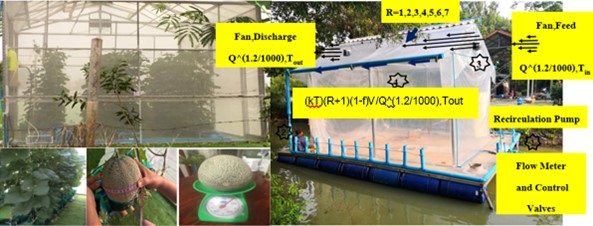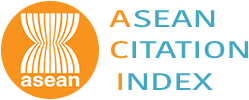Performance of Recirculation Flow Roof in Wastewater Treatment Systems for Temperature Control Modeling in Floating Melon Greenhouses
Keywords:
Dynamic model of Plug-Flow Volume Temperature Reactor , Dynamic model of Completely-Mixed Stirred Volume Temperature Reactor , Mathematical of Control Temperature in Floating Greenhouse for Wastewater TreatmentAbstract
Background and Objectives : This study on hybrid mathematical modeling aims to enhance the sustainability of agricultural practices in the Chi River basin by developing a wastewater treatment system for high-yield greenhouse cultivation. This system is expected to reduce financial risks associated with flooding and mitigate the worsening degradation of the Chi River. The researcher has designed a rooftop wastewater treatment system using mathematical modeling to regulate the temperature in floating melon greenhouses, addressing both flood-related challenges and wastewater issues. The system utilizes the sloped greenhouse roof (tilted at 20 degrees) to remove biochemical oxygen demand (BOD), ammonia (NH3), and nitrate (NO3) from wastewater. Furthermore, mathematical models were developed to regulate greenhouse temperature, including the Plug-Flow Volume Temperature Reactor (PFVTR) and the Completely-Mixed Stirred Volume Temperature Reactor (CSVTR). These models, based on first-order and second-order reactions (n = 1 and n = 2), control temperature (T) by adjusting the recirculation ratio (QR/Qin = R) and hydraulic retention time (HRT), utilizing the ratio of cross-sectional area to longitudinal area (AC: AL)to determine background concentration temperature (T*) and the Coefficient of Temperature (kT) for model validation.
Methodology : The CTFMG system (Control Temperature in Floating Melon Greenhouses) measures 5.0 meters in width, 3.0 meters in height, and 6.0 meters in length with a floating melon density factor (f) of 0.5 and a total volume of 90 cubic meters. The cross-sectional to longitudinal area ratio (AC: AL) is less than 1:4. The system's 18-square-meter plastic-sheet rooftop is inclined at 20 degrees. Water recirculation rates were set at 3, 4, 5, 6, and 7 liters per minute, while wastewater inflow (Qin) was maintained at 1 liter per minute. The treated wastewater was analyzed for BOD, NH3, and NO3 levels. The air exchange system operated with an airflow rate (QAin & QAout) of 576 cubic meters per day, utilizing laminar flow with hydraulic retention times (HRT) of 22.33 and 44.66 days. Temperature measurements were taken during April, the hottest month, to assess the impact on melon production. The input temperature (Tin) was controlled at 36 ± 2.5°C, and the output temperature (Tout) was recorded to determine the effect of different recirculation ratios (QR/Qin = R). Data were processed using Microsoft Excel to calculate background concentration temperature (T*), first- and second-order reaction rates (n = 1 and n = 2), and the Coefficient of Temperature (kT) for both PFVTR and CSVTR models. The accuracy of the mathematical models was verified, and the feasibility of floating melon greenhouses was assessed based on Net Present Value (NPV) and Benefit-Cost Ratio (B/C Ratio), with a one-year project lifecycle.
Main Results : Results from the study on the Control Temperature in Floating Melon Greenhouses (CTFMG) utilize a roof area of approximately 18 square meters, inclined at 20 degrees from the horizontal, for wastewater treatment using plastic sheet materials. The recirculation ratio (Recirculation ratio: QR/Qin = R) tested at values of 3, 4, 5, 6, and 7 achieved removal efficiencies for BOD, NH3, NO3 (Removal BOD NH3 NO3 Efficiency) as follows: (5.36 ± 2.59%, 2.83 ± 2.85%, and 10.00 ± 0.031%), (25.07 ± 2.56%, 20.49 ± 2.83%, and 10.75 ± 0.0295%), (30.14 ± 2.52%, 22.07 ± 2.81%, and 14.25 ± 0.0275%), (59.72 ± 2.49%, 31.29 ± 2.8%, and 23.50 ± 0.027%) and (72 ± 2.45%, 34 ± 2.78%, and 32.50 ± 0.0265%). The efficiency of temperature reduction decreased by 6.81 ± 2%, 8.36 ± 2%, 9.86 ± 2%, 11.32 ± 2%, and 12.74 ± 2%, respectively. The Control Temperature in Floating Melon Greenhouses (CTFMG) system, with a cross-sectional area to longitudinal-section area ratio (AC: AL) (< 1:4), achieved the highest treatment efficiency at R = 7, with removal rates of 72 ± 2.45% BOD, 34 ± 2.78% NH3, and 32.50 ± 0.0265% NO3, and a maximum temperature reduction efficiency of 12.74 ± 2%. The system controlled the temperature from an inlet temperature (Temperaturein: Tin) of 36 ± 2.5°C to an outlet temperature (Temperatureout: Tout) of 31.00 ± 1.5°C. From the Plug-Flow Volume Temperature Reactor (PFVTR) and Completely-Mixed Stirred Volume Temperature Reactor (CSVTR) models, first-order and second-order reactions (n = 1 and n = 2) were observed. background concentration temperature (T*) was 15.55 ± 2.0°C. The Coefficient of Temperature (kT) values for both models were as follows: 0.008, 0.00004 (1/day) and 0.0009, 0.00006 (1/day). The coefficient of determination (R²) values were 0.8398, 0.8497, 0.9306, and 0.9526. From the economic feasibility analysis of the floating melon greenhouse for agriculture, based on Net Present Value (NPV), the system yielded 1,680 THB per square meter, with a Benefit – Cost Ratio (B/C Ratio) of 1.68 and a payback period of 1 year.
Conclusions : The Control Temperature in Floating Melon Greenhouses (CTFMG) system exhibited a second-order reaction (n = 2) in the Completely-Mixed Stirred Volume Temperature Reactor (CSVTR) model. The Coefficient of Temperature (kT) was determined to be 0.00006 1/day. In terms of economic feasibility, the floating melon greenhouse demonstrated a Net Present Value (NPV) and a Benefit-Cost Ratio (B/C Ratio) that supported its financial viability, with a payback period of 1 year.
References
Ahern M., Kovats R. S., Wikinson P., Few R. , & Mattthies F. (2005). Global Health Impacts of Floods: Epidemiologic Evidence. Epidemiol Rev. , 27, 36-46.
APHA, AWWA, & WEF. (1999). Standard methods for the examination of water and wastewater. American Public Health Association.
Bell, J.H. , & R.D. Mehta. (1989). Boundary-layer predictions for small low-speed contractions. AIAA Journal 27(3), 372-374.
Catalano, P., M. Wang, G. Iaccarino, & P. Moin. (2003).Numerical simulation of the flow around a circular cylinder at high Reynolds numbers. Int J Heat Fluid Fl., 24(4), 463–469.
Environment Canada. (2017). Uses for Water In Southern Alberta. Alberta: University of Lethbridge.
Jirasak, J. (1985). Environmental Process. Khon Kaen University: Khon Kaen. (in Thai)
Jongpluempiti, J., Vengsungnle, P., Prapakarn, S., Pannucharoenwong, N., & Punnok, P. (2020). Supervisory Control for Wireless Automatic Environment Control in Oyster Mushroom House. Feat Journal,6(1), 40-49. (in Thai)
Kadlec, R.H., & Knight, R.L. (1996). Treatment Wetlands CRC Press. Inc: U.S.A.
Kadlec, R. H., & Wallace, S. D. (2009). Treatment Wetlands. (2nded). Boca Raton: CRC Press.
Meenaphant, H. (2007). Principle Analysis Theory and Practice to Study the Feasibility of the project. 2nd ed. Bangkok. Chulalongkorn University Pulishing House. (in Thai)
Metcalf, E. (1991). Wastewater Engineering. 3rd ed. New York: McGraw – Hill.
Reynolds, TD. (1982). Solutions manual for unit operations and processes in environmental engineering. California: Brooks/Cole Engineering Division.
Ruaypom, K., Yartjaroen, R., Ruaypom, K., Yartjaroen, R., Boonjue, A., Amattirat1, N., Suttiprapa, P., Vengsungnle, P., & Nuboon, T. (2015). Investigation of the length and the number of gutter optimals for chilled water circulation in hydroponics planting. Feat Journal ,1(2), 67-74. (in Thai)
Ruaypom, K., & Yartjaroen, R. (2022). The Application of Electrical Energy from Solar cells to Automatic Humidity Control System in Mushroom Farms. Feat Journal, 8(1), 58-68. (in Thai)
Samart, J., Maliwani, P., Wananlak, S., & Jirasan, K. (2019). Social Health Impact on River Deterioration: Case Study of Farmers in Li watershed, Lumphun Province. Social Sciences Research and Academic Journal,14, 79-92. (in Thai)
Schlichting H., (1979). Boundary–layer theory. Engineering University of Braunschweig, Germany. Translated by Kestin J. McGRAW-HILL book company, New York.
Shook, G. (1997). A Disaster Risk Assessment for Thailand Using a Technique of Decision Analysis. Journal of Disasters, 21(1),pp. 77-88.
Suksomboon, R., Junsiri, C., Kanyakam, S., & Tangjitjaroenkit, S. (2021a). Mathematical Model of Subsurface Recirculation Flow Constructed Wetland Domestic Wastewater Treatment for Household. Rajabat Chiang Mai Research Journal, 22, 37-48. (in Thai)
Suksomboon, R., Chanachai Uanwang, C., Poosumrong, L., & Anantasirichai, W. (2021b). Mathematical Dynamic Recirculation Plug-Flow Areal Reactor Models of Subsurface Recirculation Flow Constructed Wetland Wastewater Treatment for Floating Agriculture Using in Greenhouse. Engineering Journal Chiang Mai University, 28 (2), 55-63. (in Thai)
Suksomboon, R., Poosumrong, L., & Chuchotsakunleot, A. (2021c). Mathematical Dynamic Recirculation Completely-Mixed Stirred Tank Areal Reactor Models of Subsurface Recirculation Flow Constructed for Wastewater Treatment. Engineering Journal Chiang Mai University, 28 (3), 12-22. (in Thai)
United Nations. (1992). Internationally agreed glossary of basic terms related to Disaster Management. Geneva: United Nations.
Zafarzadeh, A., Bina, B., Nikaeen, M., Movahedian Attar, H., & Hajian nejad, M. (2010). Performance of moving bed biofilm reactors forbiological nitrogen compounds removal from wastewater nitrification-denitrification process. Iranian Journal of Environmental Health Science & Engineering, 7(4), 353-36.

Downloads
Published
How to Cite
Issue
Section
License
Copyright (c) 2025 Faculty of Science, Burapha University

This work is licensed under a Creative Commons Attribution-NonCommercial-NoDerivatives 4.0 International License.
Burapha Science Journal is licensed under a Creative Commons Attribution-NonCommercial-NoDerivatives 4.0 International (CC BY-NC-ND 4.0) licence, unless otherwise stated. Please read our Policies page for more information



